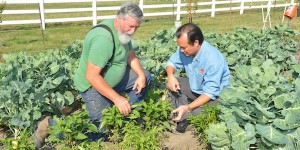
Lie Tang’s research in field robotics offers a glimpse into the future of organic agriculture.
Tang, an associate professor in the Department of Agricultural and Biosystems Engineering, develops robotics technologies for intra-row weed removal in vegetable crops. He hopes that by perfecting this technology, he can design an automated robot to lower the level of labor and chemical inputs in small to mid-sized growing operations for farmers who are looking for environmentally friendly weeding alternatives.
Tang, a native of China, was drawn to Iowa State University in 2004 by the reputation of the agricultural and biosystems engineering department as being on the forefront of agricultural innovation. “This is one of the best places in the world for agricultural robotics and automation,” he says.
Robotic response
After talking with Iowa growers of small to mid-size vegetable plots, Tang recognized a hole in current weeding approaches that robotics could fill.
“Weeding has been a long-standing problem for many years because there is no silver bullet—there are just too many variables. And for organic farmers, their options are very limited. Their options are either chemical, laborious or expensive,” says Tang. “My robot design offers the producer a more effective and sustainable alternative.”
For organic farmer Ken Blackledge, owner of Black Cat Acres in Nevada, Iowa, the battle with weeds occupies much of his time and energy.
“If a robot could weed a diverse crop planting and be cost effective I would be interested. Management of weeds is one of the biggest challenges I face. The costs involved take resources away from crop development, time needed to market and other more productive activities,” says Blackledge.
A key part of the small weeding robot is the sensing system used to distinguish produce from weed. Real-time vehicle location in reference to plants, rows and landscape will be monitored and adjusted based on two-dimensional and three-dimensional data.
“There are other, larger weeding robots on the market. But these are designed for much larger growing operations and require high accuracy GPS systems—few farmers in Iowa can buy that type of equipment,” says Tang. “The robot will take pictures with three-dimensional sensors to provide more robust information than a conventional camera.”
The time of flight of light data will be used to calculate distance, and give a picture of what types of plants are growing in the row. If a weed is found, the small actuators on the robot disturb the soil around the crop and within the row, removing any weeds mechanically without disturbing the crop. The small robot will be designed to travel over planting rows without disturbing the seeded crops, such as carrots, beans, lettuce, sweet corn and many other vegetable crops.
By getting as close as possible to the plants, the robot is able to autonomously remove weeds without the use of herbicides or plastic sheeting while increasing production.
Technology that transforms
Kathleen Delate, professor of horticulture and co-principal investigator, has been enthusiastic about the potential the project holds for organic farmers. She says that not only does the robot offer alternatives to herbicides, it also considers the importance of soil structure.
“Robotic technology for weeding offers promising options for all producers by decreasing labor to manage weeds but also potentially alleviating soil compaction that could occur with tillage. Organic producers especially are interested in this technology because herbicides are disallowed in organic production, and with the increasing problem of herbicide resistance, more and more producers will be looking for alternatives,” says Delate.
Tang’s research group and collaborators had originally manufactured a larger, slightly more cumbersome robot that served as inspiration for the new, smaller and more aesthetic design. “In this generation of robot, we are integrating sensing and controls together to fine tune the robot’s capabilities,” says Brian Steward, professor of agricultural and biosystems engineering and co-principal investigator. “This technology is potentially transforming.”
The future is now
As Steward explains, automation and sensors are developing rapidly. Precision agriculture technologies are quickly being adopted, and thus transforming the farming lifestyle and industry. In order for these technologies to run properly and be maintained, the next generation of agricultural engineer is being trained early to embrace robotics.
“My sons are participating in FIRST robotics competitions,” says Steward. “Students are learning to design robots as children. As they move forward in their education, it increases our society’s aptitude with robotics. If we are going to adopt robots in agriculture, we need people who can build and repair them. That’s happening now.”
As the project moves forward, Tang recognizes there will be obstacles, including economic feasibility. However, he’s proud of the attention his peers have given his work—this marks one of the first times agricultural field robotics has been included in an organic agriculture related grant.
Pioneering innovative and technologically advanced research has been a staple in the department since it’s inception in 1905. It is the birthplace of the first large round baler and whirlwind terrace plow. Over the years, scientists and professors in the department have served as leading investigators of farm mechanics, post harvest grain, farmstead structures and natural resources, proven by their many patents. A feat Tang is eager to replicate.
At this early stage of research and design, it’s hard to tell if Tang’s robot will find a place among other inventions to come out of the agricultural and biosystems engineering department. But with his team, passion and advancing robotics technology it’s not hard to imagine.
December 9, 2013 by Dana Woolley